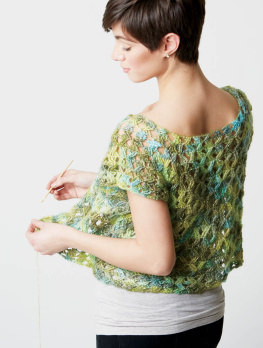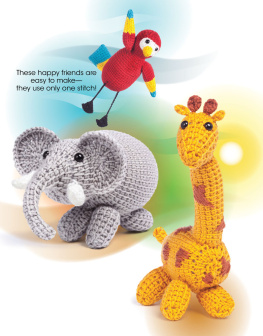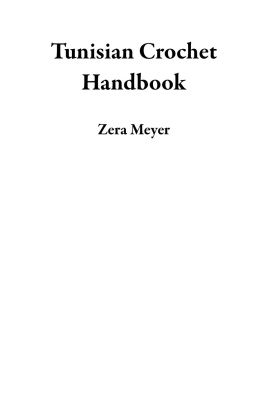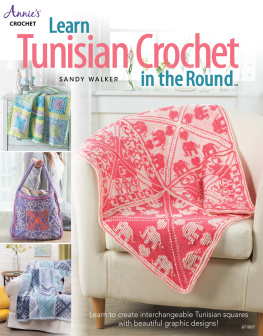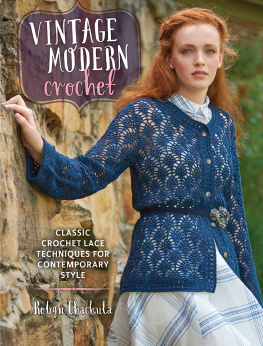THE NEW
Tunisian Crochet
Contemporary Designs for Time-Honored Traditions
Dora Ohrenstein

Dedication
This book is dedicated to my first mentor in the yarn industry, Jean Leinhauser, who passed away in 2011. She was a pioneer in the industry and is sorely missed by many.
Acknowledgments
My thanks to all the designers who contributed their outstanding creativity to this book. Im also grateful to the yarn companies who donated yarn: MadelineTosh, Tahki Stacy Charles, Manos del Uruguay, Blue Sky Alpacas, Lion Brand, Lornas Laces, Malabrigo, and Skacel Knitting. The quality of these yarns really helps make the projects shine. Lastly, thank you to everyone at Interweave who has worked with me to bring this book to fruitionits a pleasure to work with such professionals!
Contents
Andrea Graciarena
Charles Voth
Vashti Braha
Doris Chan
Dora Ohrenstein
Lily Chin
Lisa Daehlin
Dora Ohrenstein
Margaret Hubert
Dora Ohrenstein
Dora Ohrenstein


Almost everything about Tunisian crochet has come under dispute at some point, including its history, origin, attractiveness, utility, and even its name. Perhaps its this very mystery that entices the modern crocheter to explore the technique. So what is this thing called Tunisian crochet?
Tunisian crochet is often considered to be a hybrid between knitting and crochet, and the description is apt. The tool used is a long hook that appears to be a cross between a 14-inch straight knitting needle and a crochet hooka long, smooth shaft with a hook at one end and a stopper at the other. Unlike standard crochet, where each stitch is worked and finished as you go, in Tunisian crochet, stitches are picked up in one direction, called the forward pass, then finished in the opposite direction, called the return pass. The resulting fabric is different from both crochet and knitting, displaying unique qualities all its own. Because stitches are linked in both the vertical and horizontal directions, the fabric produced by Tunisian crochet is firm but flexible. It stretches less than standard crochet, particularly in the horizontal direction, but nevertheless has an elastic quality. As with standard crochet, choosing yarns of different weights and fibers will have a significant effect on the finished fabric, as will the choice of stitch pattern.
A BRIEF HISTORY
I have found absolutely no evidence that Tunisian crochet was ever done in Tunisia, a country of rich textile traditions, especially in weaving and embroidery. Some evidence suggests it couldnt have begun there, as much of the population of the area are Berbers, whose custom actually forbade women to use needles and hooks. In fact, the origins of Tunisian crochet are unknown, since no samples of the craft have been found that predate the twentieth century. What is known is that instructions for pieces using the technique appear in Europe around the same time as standard crochet, in the mid-nineteenth century. Not long after, it appeared in U.S. needlework magazines as well. The second half of the nineteenth century saw a huge increase in the publication of instruction books for all the needle arts, and Tunisian crochet was regularly featured along with knitting, crochet, macram, and other crafts then popular with women. It was, however, often not referred to as Tunisian at the time, but as any one of several other names.
Tricot Ecossais, a French term meaning Scottish knitting, was the term used by Mademoiselle Riego de la Branchadire, a highly accomplished needle artist and publisher of hundreds of pattern books. Her patterns featuring the technique, published in the 1860s, are among the earliest published Tunisian crochet patterns. This name has led some writers to associate the technique with shepherds knitting and to suggest a Scottish origin. But shepherds knitting refers to a slip-stitch technique wholly unlike the technique involved in Tunisian crochet.
Tunisian crochet was the term used in the well-known Encyclopedia of Needlework, by Thrse de Dillmont, first published in 1884 and still available today. It states:
Crochet work may... be divided into two kinds, German crochet, and Victoria or Tunisian crochet; the latter is known also under the name of tricot-crochet.
Unfortunately, the author offers no further insight into the terminology, nor does she provide any link to Tunisia.
The Dictionary of Needlework, by Sophia F. A. Caulfeild, originally published in 1882, includes this entry under the term tricot stitch:
Tricot Stitch.Also known as Tunisian Crochet, Railway, Fools and Idiot Stitch.
Tricot is the French word for knitting, and the use of a long hook where stitches remain on the needle probably explains why this term was used. The instructions that follow are for Tunisian simple stitch. This reference describes a handful of additional Tunisian stitches, including one called Tricot Ecossais, a stitch you can find in our stitch dictionary on . The same term Riego used to describe a techniqueall her patterns use Tunisian simple stitchwas, twenty-seven years later, used as a term for one stitch among several. As to the rather disparaging term idiot stitch, it arose because the stitch was so easy to do, and our own term simple stitch may be a more polite way of referring to the same characteristic.
Weldons Practical Needlework, a popular British magazine, often included patterns made in Tricot. A study of Weldons patterns shows the kinds of items, stitches, and designs that were popular at the time (see ).
The term Afghan stitch to describe Tunisian simple stitch was used in ladies magazines beginning in the 1880s, while other names continued to circulate as well. How afghan became synonymous with blanket is beyond our current scopethe link to the country of Afghanistan is as doubtful as that between Tunisian crochet and Tunisia. In any case, it seems the thick fabric created by the stitch was considered appropriate for the purpose, as it still is today.
The distinguished scholar of knitting history Richard Rutt, in A History of Hand Knitting, writes:
Whether [Tunisian crochet] came from north Africa or not is unknown. It appeared in England about 1860 and was then claimed as a new invention, crochet tricoter, by Mee and Austin in an advertisement.
Samples of Tunisian crochet from Weldons Practical Needlework

Childs Dress in Tricot and Crochet.

Tea Cosy in Tricot. Limpet Shell Pattern.

Details of Tricot Stitch for Tea Cosy.


